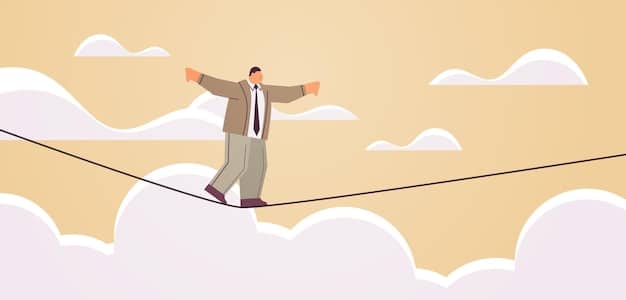Paycheck to Paycheck: Shocking Stats on American Financial Strain

An astonishing revelation indicates that over 70% of Americans are living paycheck to paycheck, highlighting a pervasive financial vulnerability despite varying income levels and signifying deep-rooted economic challenges within the nation.
Dive into the startling reality of American finances: the staggering number of people living paycheck to paycheck. This isn’t just about low-income earners; it affects a wide spectrum, revealing unsettling truths about economic stability in the US.
The Alarming Reality of Paycheck-to-Paycheck Living
The phrase “living paycheck to paycheck” often conjures images of minimum wage earners struggling to make ends meet. However, the disconcerting reality is that this financial precariousness affects a significant portion of the American population, transcending income brackets and socioeconomic statuses.
Recent studies have painted a stark picture, revealing that a substantial majority of Americans, regardless of their earnings, find themselves in a position where their expenses consume their income each month, leaving little to no room for savings, investments, or unexpected financial setbacks. The implications of this lifestyle are far-reaching, impacting not only individual well-being but also the broader economic landscape.

The Scope of the Problem
Understanding the sheer scale of this issue is critical to grasping its significance. It’s not merely a fringe phenomenon but a widespread reality that touches the lives of millions of Americans. Breaking down the statistics and demographics can shed light on who is most affected and why.
- High-Income Earners Also Affected: It’s not just those with low wages; even individuals earning six-figure salaries can find themselves in this cycle due to high expenses and lifestyle inflation.
- Geographic Disparities: The cost of living varies significantly across different states and cities. In high-cost areas, even a decent salary may not be enough to comfortably cover expenses.
- Impact on Retirement Savings: Living paycheck to paycheck often means sacrificing long-term financial goals like retirement savings, creating future financial insecurity.
The challenge of living paycheck to paycheck extends beyond immediate financial constraints. It creates a domino effect, impacting long-term financial health and perpetuating a cycle of stress and uncertainty.
Factors Contributing to Paycheck-to-Paycheck Existence
Several factors converge to create the perfect storm that traps so many Americans in this financial cycle. These factors range from economic trends and societal shifts to individual financial habits and planning.
Examining these contributing elements is essential for understanding the multifaceted nature of the problem and developing effective solutions. Each factor plays a unique role, and addressing them requires a comprehensive and nuanced approach.
Rising Living Expenses
One of the primary drivers of this phenomenon is the relentless increase in the cost of essential goods and services. From housing to healthcare, expenses are outpacing wage growth, making it increasingly difficult for individuals and families to keep up.
The affordability crisis in various sectors is squeezing household budgets and leaving less room for financial maneuverability. Understanding these rising costs is crucial for contextualizing the paycheck-to-paycheck reality.
- Housing Costs: Rent and mortgage payments have surged in many areas, consuming a significant portion of household income.
- Healthcare Expenses: Medical bills and insurance premiums continue to rise, placing a heavy burden on individuals and families.
- Education Debt: Student loan debt is a major contributor, often requiring substantial monthly payments that limit financial flexibility.
Addressing the rising cost of living requires policy interventions, innovative solutions, and a collective effort to ensure affordability and access to essential services.
The Psychological Toll of Financial Instability
Beyond the practical challenges, living paycheck to paycheck exacts a significant psychological toll on individuals and families. The constant stress and anxiety associated with financial insecurity can have detrimental effects on mental and physical health.
The emotional burden of financial instability is often overlooked, but it plays a crucial role in overall well-being. Recognizing and addressing this psychological impact is essential for fostering resilience and promoting financial wellness.

Stress and Anxiety
The fear of not being able to meet financial obligations can lead to chronic stress and anxiety, affecting sleep, relationships, and overall quality of life. The uncertainty of the future adds to the emotional burden.
This constant state of alert can have long-term consequences on mental health, leading to burnout and other stress-related conditions. Understanding the link between financial stress and mental well-being is critical.
- Impact on Relationships: Financial stress can strain relationships, leading to conflicts and discord within families.
- Health Consequences: Chronic stress is linked to various health problems, including heart disease, depression, and weakened immune function.
- Reduced Productivity: Financial worries can impair concentration and productivity at work, further exacerbating the problem.
Promoting financial literacy and access to mental health resources can help individuals manage the psychological toll of financial instability and build greater resilience.
Strategies for Breaking the Cycle
While the challenges of living paycheck to paycheck are significant, there are actionable strategies individuals can adopt to break free from this cycle and build a more secure financial future. These strategies involve a combination of budgeting, saving, and smart financial planning.
Empowering individuals with the knowledge and tools to take control of their finances is key to fostering lasting change. The following strategies can serve as a starting point for building a more stable financial foundation.
Budgeting and Expense Tracking
Creating a detailed budget and tracking expenses is the first step toward gaining control of finances. Understanding where money is going is essential for identifying areas where spending can be reduced and savings can be increased.
Budgeting is not about restricting oneself but about making informed choices and allocating resources in a way that aligns with financial goals. It requires discipline and consistency, but the rewards are well worth the effort.
- Create a Realistic Budget: Base the budget on actual income and expenses, and prioritize essential needs over discretionary spending.
- Track Expenses Regularly: Use budgeting apps, spreadsheets, or notebooks to monitor spending and identify areas where adjustments can be made.
- Set Financial Goals: Define short-term and long-term financial goals, such as saving for an emergency fund, paying off debt, or investing for retirement.
Regular budget reviews and adjustments are necessary to ensure the budget remains relevant and effective in achieving financial goals. Flexibility and adaptability are key to long-term success.
The Role of Financial Literacy
A lack of financial literacy contributes significantly to the prevalence of paycheck-to-paycheck living. Many individuals lack the knowledge and skills necessary to make informed financial decisions, leading to poor budgeting, excessive debt, and missed opportunities for saving and investing.
Promoting financial literacy is crucial for empowering individuals to take control of their finances and build a more secure future. Financial education should start early and continue throughout life to equip people with the tools they need to navigate complex financial landscapes.
Improving Financial Education
Integrating financial education into school curricula and community programs can help individuals develop a solid understanding of basic financial concepts. Topics such as budgeting, saving, investing, and debt management should be covered.
Accessible and engaging financial education can make a significant difference in individuals’ ability to make sound financial decisions and avoid common pitfalls. It’s an investment in the future, fostering financial independence and resilience.
- Early Financial Education: Start teaching children about money management from a young age, instilling good financial habits early on.
- Community Programs: Offer free or low-cost financial literacy workshops and seminars in communities to reach a wider audience.
- Online Resources: Utilize online resources, such as financial websites, apps, and courses, to learn about financial concepts and strategies.
Financial literacy empowers individuals to make informed decisions, avoid costly mistakes, and build a solid foundation for financial security. It’s a key ingredient for breaking the paycheck-to-paycheck cycle.
Government and Policy Interventions
Addressing the issue of paycheck-to-paycheck living requires a multifaceted approach that includes not only individual efforts but also government and policy interventions. Systemic changes are needed to address the root causes of financial instability and create a more equitable economic landscape.
Policy interventions can play a crucial role in alleviating financial strain, promoting economic opportunity, and ensuring a basic standard of living for all Americans. These interventions should be targeted, evidence-based, and designed to address the specific challenges faced by different segments of the population.
Policy Recommendations
Several policy recommendations can help address the issue of paycheck-to-paycheck living, including raising the minimum wage, expanding access to affordable healthcare and housing, and reducing student loan debt.
These policy changes can have a significant impact on individuals’ financial well-being, providing them with greater economic security and opportunity. They are essential for creating a more just and equitable society.
- Raise the Minimum Wage: Increasing the minimum wage can help low-wage workers earn a living wage and reduce their reliance on public assistance.
- Expand Access to Affordable Healthcare: Affordable healthcare can prevent medical debt and ensure individuals can access necessary medical care without financial hardship.
- Reduce Student Loan Debt: Student loan debt relief and reforms can alleviate the burden of debt and free up resources for saving and investing.
Policy interventions should be designed to create a more level playing field, ensuring that all Americans have the opportunity to achieve financial security and prosperity. They are a crucial component of a comprehensive strategy for addressing the issue of paycheck-to-paycheck living.
| Key Point | Brief Description |
|---|---|
| 💰High Cost of Living | Housing, healthcare, and education expenses have increased, surpassing wage growth. |
| 😰Psychological Toll | Financial instability leads to stress, anxiety, and impacts on mental health. |
| 🌱Strategies to Break Free | Budgeting, reducing debt, and saving are essential to financial stability. |
| 📚Financial Literacy | Improving financial education helps individuals make informed decisions. |
Frequently Asked Questions
▼
Living paycheck to paycheck means that nearly all of your income is spent covering monthly expenses, leaving little to no savings or financial cushion for unexpected costs.
▼
While it affects people across income levels, it disproportionately impacts lower-income individuals, minority communities, and those with significant debt or high living expenses.
▼
Begin by tracking your income and expenses for a month. Then, create a budget that prioritizes needs over wants and allocates funds for savings and debt repayment.
▼
Consider cutting back on non-essential subscriptions, eating out less frequently, and finding more affordable alternatives for utilities or transportation to save money.
▼
Look to certified financial planners, reputable financial websites, and community-based financial literacy programs for sound guidance and support in bettering your financial health.
Conclusion
The fact that over 70% of Americans are living paycheck to paycheck is a stark reminder of the financial challenges many face. By understanding the causes and implementing practical strategies, individuals and policymakers can work together to build a more secure financial future for all.





